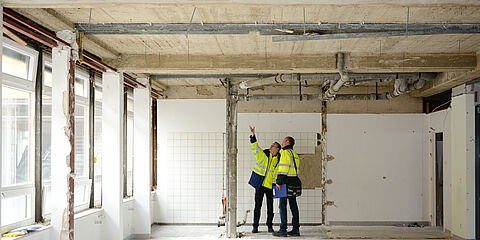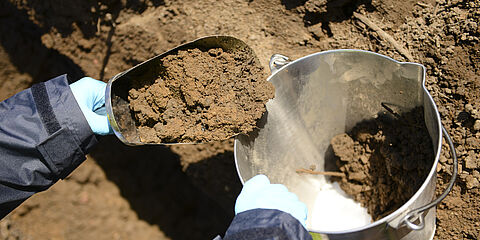Radon in construction land and buildings
Radon (Rn-222) is a naturally occurring radioactive noble gas that is formed in the ground from the radioactive decay of rocks containing uranium. It can penetrate buildings through leaks.

Radon decays into other radioactive nuclides such as polonium, lead and bismuth (solids), which can accumulate in buildings. The amendment to the Radiation Protection Act of 31 December 2018 provides for measurements and, if necessary, protective measures for workplaces and recreation rooms.
The background: About 35 percent of the average natural and artificial radiation exposure of the German population is due to indoor radon. Radon is colourless, odourless and tasteless. It enters houses through leaks via gas-permeable floors in the building envelope, in the area of building components in contact with the ground and through pressure differences (outside/inside). Since radon is unstable (half-life 3.8 days), it decays into other radioactive solids. These can accumulate in buildings by the solids binding with dust. The radioactive particle-bound nuclides of radon and also radon itself (small proportion) can be stored in the lung tissue or react with the lung tissue as a radioactive gas. The decay takes place continuously, releasing the biologically effective alpha and beta radiation.

Reduction measures must be implemented by establishing radon precautionary areas where radon activity concentrations are expected to exceed the reference value of 300 bq/m³, on average per year, in buildings with common rooms and workplaces. The relevant authorities of the German Federal States must designate these precautionary areas by 31 December 2020. In addition to long-term measurements, which are carried out with passive nuclear track dosimeters over a period between several months to one year, WESSLING uses active measuring devices to search for the penetration paths of radon.
Active and directly indicating devices are also used for the investigation of the subsoil in the run-up to the planning of construction sites. According to these results, the execution of components in contact with the ground can be aligned. As other gas permeabilities of the subsoil can occur even at short intervals, one possible radon-reducing measure may be a simple change of position of the planned building.
There are other possible measures for radon avoidance in existing buildings. These include sealing in the exterior or interior, ventilation facilities and subsequent gas drainage. According to our individual planning, the successful application is controlled and documented with intermediate tests and final inspections.
Our range of services:

- Long-term measurements in relevant rooms of buildings
- Direct-indicating measurements in the building stock to search for leaks
- Directly indicating measurements of soil air in the subsoil
- Expert evaluation of the measurement results
- Recommendations for the location and design of new buildings
- Planning and site management of the refurbishment of existing buildings
- Partial and final checks for safe execution
Your contact regarding radon
- Dr. Heidi Doose
- +49 511 5470050
- heidi.doose@wessling.de



